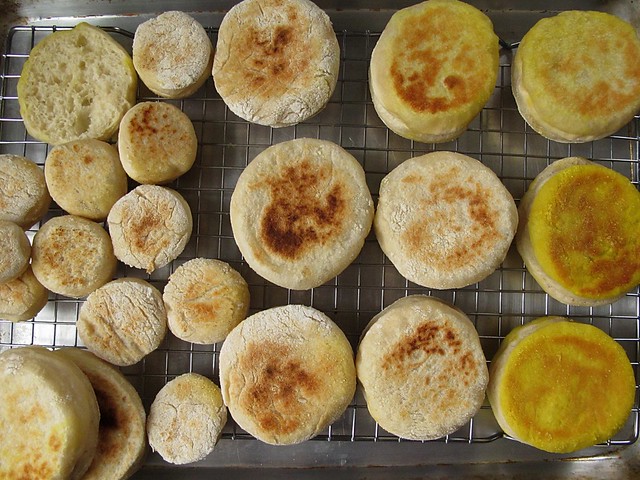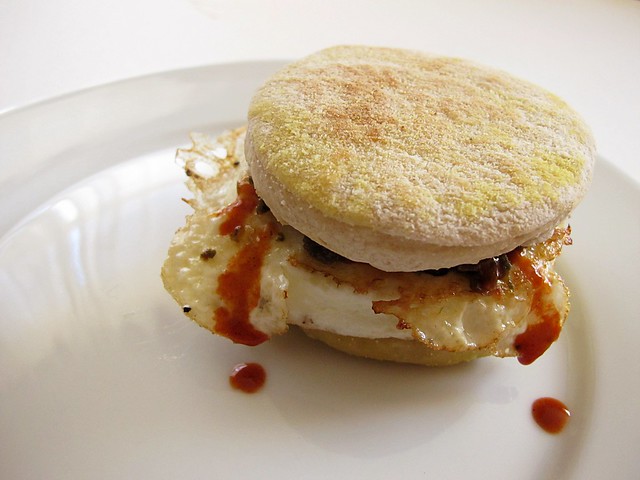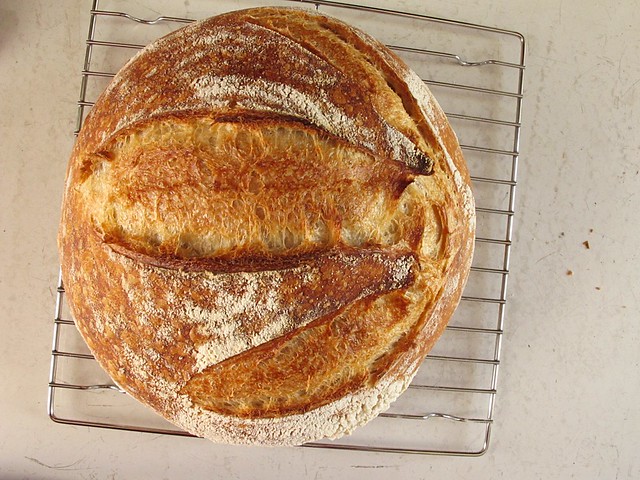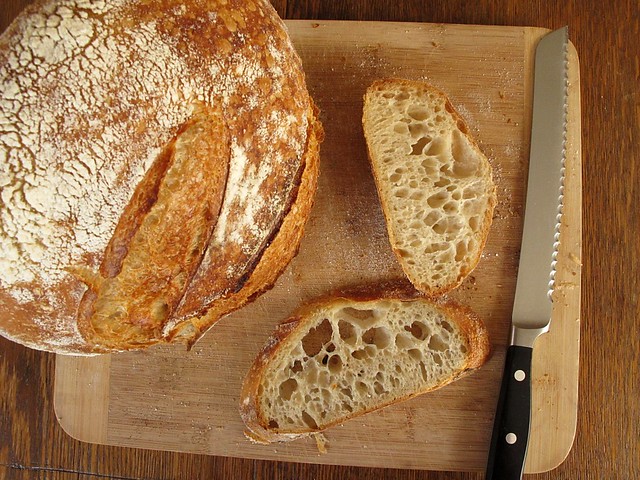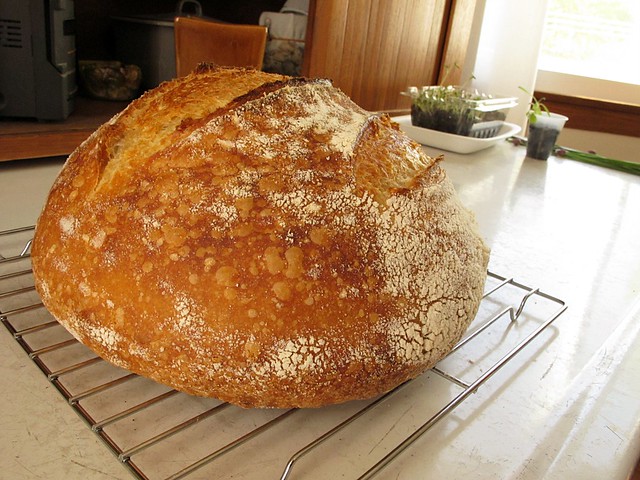This is the second time I've participated in a newly formed baking group Sourdough Surprises. The monthly bake-along choice for September was English muffins, a baked good particularly close to my heart. Over a year ago, I worked tirelessly trying to perfect the sourdough English muffin; I made so many English muffins in a week, that I knew I had to hit on something - and I definitely did. (This final version I thought was the best, but all of my trials were completely edible).
When I read the challenge was going to be English muffins, I knew there could be no better time than now to test-drive another Tartine dough. I already knew it to be wonderful, since it was one that Chad Robertson had based his famous baguettes on. That same dough was coaxed into a classic, muffiny shape... and it did not disappoint.
When I read the challenge was going to be English muffins, I knew there could be no better time than now to test-drive another Tartine dough. I already knew it to be wonderful, since it was one that Chad Robertson had based his famous baguettes on. That same dough was coaxed into a classic, muffiny shape... and it did not disappoint.
Did you notice the bright yellow exteriors on a few of the muffins?
That's because I used my cast iron skillet the day before to fry some
vegetables in turmeric. It stained the pan.
The dough is a hybrid of commercial yeast and sourdough starter. A poolish, created by letting a small amount of active dry yeast ferment in a flour mixture for several hours, is combined with sourdough starter (in my case, the 100% hydration starter that I keep perpetually on my counter). I altered the amounts to suit one sheet pan, but otherwise, it is the very same dough that made this thin-crusted, naturally seamed loaf named Fendu. I loved this bread wholeheartedly, so I knew that the same dough coerced into English muffin form would also delight.
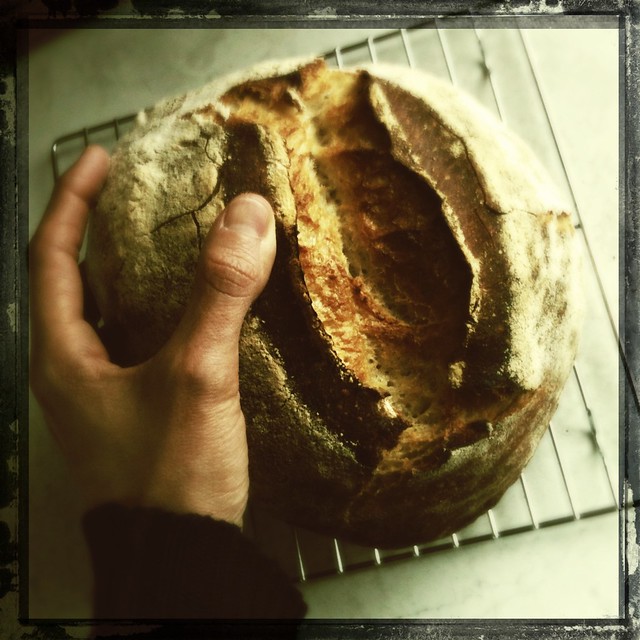
What I loved about this recipe, is that the bulk of the work is done the day before. When you bake the muffins, you have only to cut them out with a circle cutter, and fry them in some butter - clarified if you follow the Tartine instruction. I cut some of the leftover spaces into tiny, bite-sized muffins, but I don't think the scraps would rise much if re-rolled. There was a small lump of dough that was sacrificed.

Since I keep my starter well fed and ready to go, I do not mix Robertson's "leaven" as directed for this particular recipe. I instead substitute the same amount of starter. and make sure that I feed it just a little bit before building the poolish. (Since the poolish is mature and ready in about 4 hours, and my starter is most active 4-6 hours after feeding, I mix the poolish about an hour after feeding my starter for the day.)
Tartine-Method Sourdough English Muffins (adapted for starter and quantity from Chad Robertson)
yield 1 dozen 3-inch muffins, plus a few bite-sized
poolish:
- 100 g. ap flour
- 100 g. water
- 1 1/2 g. active dry yeast
to build dough:
- 200 g. well fed starter (a teaspoon should float in a glass of water)
- 250 g. water
- 200 g. poolish (it should be all of the above)
- 325 g. ap flour
- 175 g. bread flour
- 12 g. salt (but I feel this is too salty. I actually salt to taste - I add 1 1/2 t. kosher salt, and taste the dough to correct.)
To make the poolish, mix everything in a small bowl, and let ferment 3-4 hours at room temperature (or overnight in the fridge, but I haven't done that).
(Both the poolish and the starter should pass the "float test" as described above; a teaspoon should float in a glass of water.)
To mix the dough, pour the water into a large bowl. Add the poolish and starter and stir to blend well. Add the ap and bread flours, and use your hands to mix well until no floury bits remain. Let the dough rest for 30 minutes. I didn't forget about the salt: we won't add it just yet.
Transfer the dough to a large, clean, clear container for the bulk fermentation. Bulk ferment should take about 4 hours, and every 40 minutes, fold the dough. The salt should be added with the first turn (or 40 minutes after transferring to the clean bowl.
When the bulk fermentation is complete, turn the dough out onto a well-floured towel (use flour that is 1/2 regular ap flour and 1/2 rice flour - it prevents sticking really well) that is spread flat over a sheet pan. Let it rest for 10 minutes in a mound, then dust the top with rice flour/ap flour mix and ease the dough into a rectangle of even thickness. Dough should be about 1 inch thick; aim for uniform thickness overall. Cover with a clean, lint-free towel, and place in the fridge to rise overnight or 8 hours. (I worried that it would dry out, so I placed some plastic bags loosely over the top of the towel.)
Take the dough out of the fridge 30 minutes before baking them. Ready a heavy cast iron skillet, and clarify some butter if you like. Do not cut the muffins until ready to place them in the skillet.
Brush the skillet with butter, cut a 3-inch round of dough and immediately place it in the hot pan. Pick up each carefully, and hopefully you used enough flour and nothing sticks! (In a number 8 skillet, I could fit 3 muffins at a time easily.) Cook for 2-3 minutes on the first side, until brownish - or as brownish as sourdough can get. Carefully flip, and continue cooking 2-3 minutes more until they appear done. Try to let them cool somewhat before slicing, they continue to cook for a minute or two after removing them from the heat.
(Robertson says they'll keep well in a covered container at room temp for a day or two, but I prefer to freeze what I can't eat in a day. Let them come to room temperature before splitting them open and toasting them, but that can take up to 2 hours. An impatient bread fiend can dangerously wiggle a paring knife around enough to split a mostly frozen puck enough to get it into the toaster oven. But that does involve a stabbing hazard. You have been warned.)
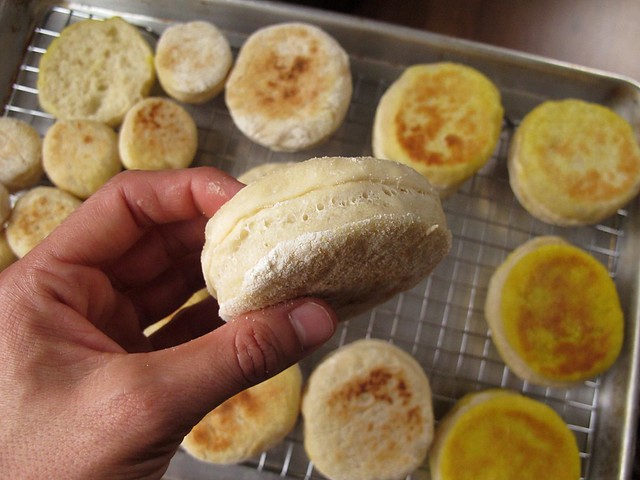
I really liked these muffins, but I can't say that I liked them any more than the ones I've made in the past. I think because I first used this dough as a loaf bread, that flavor of bread lingered in my mind, the craggy holes of English muffin-dom seemed imbued with regular bread flavor. Because other recipes I've made had a bit of whole wheat flour and a small amount of milk and/or sweetener, the texture of the middles seemed more akin to what I think of as a true English muffin. But that is all just particulars, since this is a perfectly respectable muffin in all ways.
And, since they rest overnight - it feels like there is no mess the next day when you go to bake them.
|
Oh, and be sure to check out the other participants:


